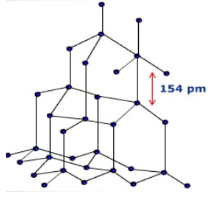(1) B2H6 contains 4-Terminal H are bonded by Sigma bond and remaining 2-H are bridging hydrogen’s and of these are broken
then dimer become monomer.
(2) Boron undergoes sp3 hybridisation 3 of its
sp3 hybridised orbitals contain one( e¯) each and fourth sp3
hybrid orbital is vacant.
(3) 3-(Three) of these sp3 hybrid orbitals
get overlapped by s orbitals of 3-hydrogen atoms.
(4) One of the sp3 hybrid orbitals which have
been overlapped by s orbital of hydrogen gets overlapped by vacant sp3
hybrid orbital. Of 2nd Boron atom. And it’s vice versa.
(5) By this two types of overlapping take place
4 (sp3– s) overlap bonds and 2(sp2 – s – sp3) overlap
bonds.
(6) H is held in this bond by
forces of attraction from B and This bond is called 3 centred two electron
bonds (3C-2e bond) . Also called Banana bonds. Due to repulsion between the two
hydrogen nuclei, the delocalised orbitals of bridges are bent away from each
other on the middle giving the shape of banana.
(7) The two bridging
hydrogens are in a plane and perpendicular to the rest four hydrogen..
ILLUSTRATED EXAMPLE (1): In Diborane
(A) 4 bridged hydrogens and two terminal hydrogen are
present
(B) 2 bridged hydrogens and four terminal hydrogen are
present
(C) 3 bridged and three terminal hydrogen are present
(D)None of the above
ILLUSTRATED EXAMPLE (2): Which one of the following
statements is not true regarding diborane?
(A) It has two bridging hydrogens and four perpendicular
to the rest.
(B) When methylated, the product is Me4B2H2.
(C) The bridging hydrogens are in a plane and
perpendicular to the rest.
(D ) All the B–H bond distances are equal
ILLUSTRATED EXAMPLE (3): The structure of diborane
(B2H6) contains
(A) Four (2C–2e–) bonds and two (2C–3e–) bonds
(B) Two (2C–2e–) bonds and two (3C–2e–) bonds
(C) Four (2C–2e–) bonds and four (3C– 2e–) bonds
(D )None of these
ILLUSTRATED EXAMPLE (4): The molecular shapes of diborane is shown:
Consider the following statements for diborane:
1. Boron is approximately sp3 hybridised
2. B–H–Bangle is 180°
3. There are two terminal B–H bonds for each boron atom
4. There are only12 bonding electrons available
Of these statements:
(A ) 1, 3 and 4 are correct (B) 1,
2 and 3 are correct
(C) 2, 3 and 4 are correct (D) 1, 2 and 4 are correct

























